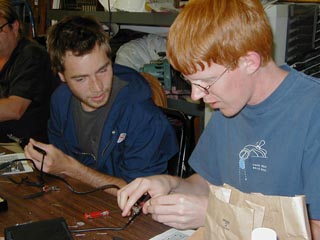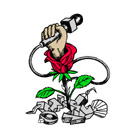Free Radio Berkeley 2017 Workshop Schedule
 |
 |
Summer Radio Camp
Watts Happening in 4 Days
A four day DIY workshop session sponsored by Free Radio Berkeley in which you learn how to build either a 10, 40 or 150 watt FM broadcast (88-108 MHz, standard FM band) transmitter (and other related items such as antennas) and set up a low power community radio station capable of covering a broadcast radius up to 10-15 miles depending on terrain and antenna height.
With an emphasis on direct, hands-on learning, you will learn how to solder, identify electronic components, assemble an FM broadcast transmitter from a kit of parts, build and tune an antenna, properly setup and test broadcast equipment and much more. Further, you will be given an overview of basic electronics and broadcast engineering.
A workshop fee of $200 to $300 sliding scale is charged. At the end of the radio camp session you may purchase the 40 watt transmitter for $450 or the 10 watt transmitter for $300 or the 150 watt transmitter for $650 - the cost of the kit, power supply and enclosure. An entry level 10 watt transmitter kit made in China is available for $60. All participants will assemble an AM/FM radio kit which is included in the workshop fee.
The camp is open to anyone 16 years and older. The Radio Camp session runs Friday through Monday (10 a.m. to 6 p.m.). It will be held at FRB’s shop in Rodeo, CA.
Make Radio Not War! Restore media democracy and break the corporate stranglehold on the free flow of information, ideas, art and cultural expression by establishing an FM broadcast station in your neighborhood or community. Contact Free Radio Berkeley for any questions or further information.
Workshop fee -$200-$300 sliding scale,
Session are from 10 A.M. to 6 P.M.,
Friday through Monday.
To register, you may:
Sign up through Eventbrite: Click here to sign up
Send your name and contact information to Free Radio Berkeley via email or regular mail
By phone: 510-799-1779
2017 Summer Radio Camp Date:
September 1- 4
Donate A Transmitter
If you would like to have the experience of building a transmitter but do not wish to engage in broadcasting, please consider assembling a transmitter at one of our camps and donating it to a community in Latin America or somewhere else in the world where people need a voice.
Click here to download the Radio Camp Flyer, (PDF document)
Click here to download Micropower Broadcasting - A Technical Primer, (a 25-page, 629K, PDF document).
The primer is one of the primary documents for the Radio Camp sessions.
The Revolution Will Be Televised
From Free Radio to Free TV Broadcasting
It is now time to “Turn on, tune in and take over”. Finally, guerilla media activists will be able to say: “There is nothing wrong with your television set. Do not attempt to adjust the picture. We are controlling transmission. If we wish to make it louder, we will bring up the volume. If we wish to make it softer, we will tune it to a whisper. We will control the horizontal. We will control the vertical. We can roll the image, make it flutter. We can change the focus to a soft blur or sharpen it to crystal clarity. For the next hour sit quietly and we will control all that you see and hear. We repeat: there is nothing wrong with your television set. You are about to participate in a great adventure.” (Outer Limits intro circa 1963)
Free Radio Berkeley’s engineering staff have designed and developed low power VHF and UHF transmitters by the creative use of off-the-shelf technology. So far, design engineering efforts have yielded TV transmitters capable of reaching a distance of 4-5 miles. Estimated cost for a VHF transmitter and antenna system with an effective radiated power of 75 watts is about $500 (cost of kits & modulator), $700 to $800 for a system with an effective radiated power of 400 watts. For a UHF system, add about $300 to the above amounts. Coverage pattern is 220 degrees, not fully omni-directional. Further work is continuing on the development of antenna systems.
TV Broadcasting kits are now available, check the store catalog for kits. Any composite video source with an audio out signal can be used by the TV transmitters. Click here for a typical TV broadcast configuration diagam. Typically, most folks will most likely use a multiple disk DVD player or a computer with video files on a large capacity hard drive. Live broadcasts are certainly a possibility. This would require several video cameras and a video switcher/mixer.
A 200-disk DVD juke box style player would be able contain almost two weeks worth of material, assuming two hours per DVD. Considering the quantity of video material available, most of which will never be seen on either broadcast TV or cable/satellite feeds, there should not be any problem providing audiences with an exciting and compelling selection of material.
No doubt, the FCC, the National Association of Broadcasters and other entrenched interests will most strenuously object to Micropower or Free TV Broadcasting. What better way to respond to the total propaganda environment that has been created with television media.
Contact Free Radio Berkeley for further information:
510-799-1779 /
/
www.freeradio.org
Mailing address: 206 Parker Avenue, Rodeo CA 94572



